Sony RX100 M1: Close-Up Experiences - MagFilter Adaper Tests
This page and its companion pages discuss the macro, or better, close-up, abilities of the Sony RX100 M1. Although the camera has a macro mode (allowing shots from 5 cm), I would not call these photos "macros" and therefore use the term "close-up."
On this page, I present some experiments with close-up lenses at the MagFilter quick-change filter adapter. We use our 52 mm Marumi +5 and siocore +10 achromats (and maybe, the Dörr +10 achromat), which directly fit the adapter's filter thread. This page supersedes page Close-Up Experiences - Hand-held Close-up Lenses because the results shown here are more reliable.
Introduction
Since the lenses of the Sony RX100 models do not have a filter thread, we cannot use our existing close-up lenses with this camera. At least, we would have to buy some sort of "lens adapter" like the one that Sony sells (VFA-49R1). I found, however, another filter adapter from Carry Speed, which seemed more interesting to me, because if fixes filters and lenses to the camera lens using magnetic force. We bought the 52 mm filter thread version, because this fits our close-up lenses.
Setting the Stage...
The Achromats
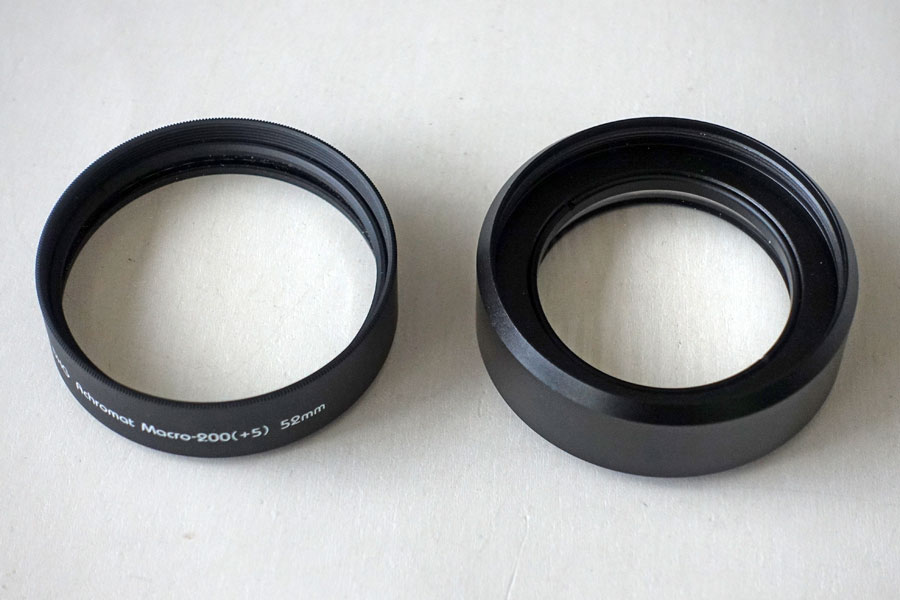 |
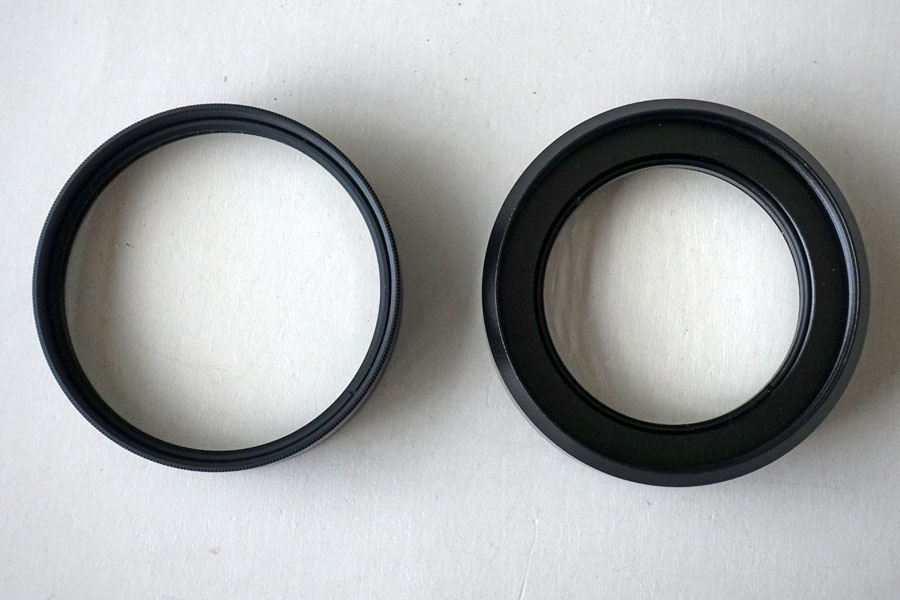 |
|
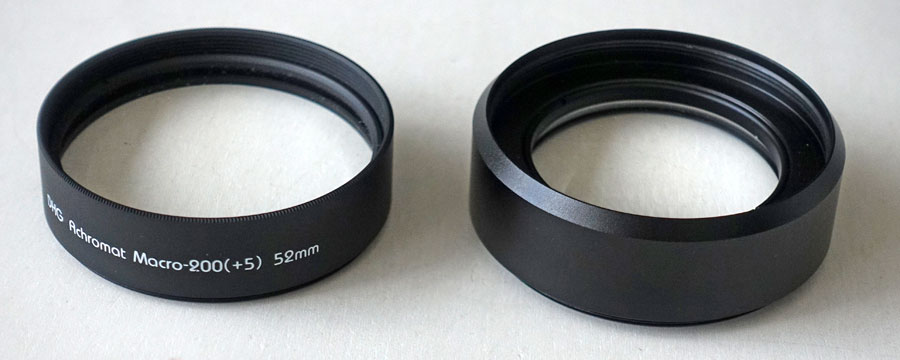 |
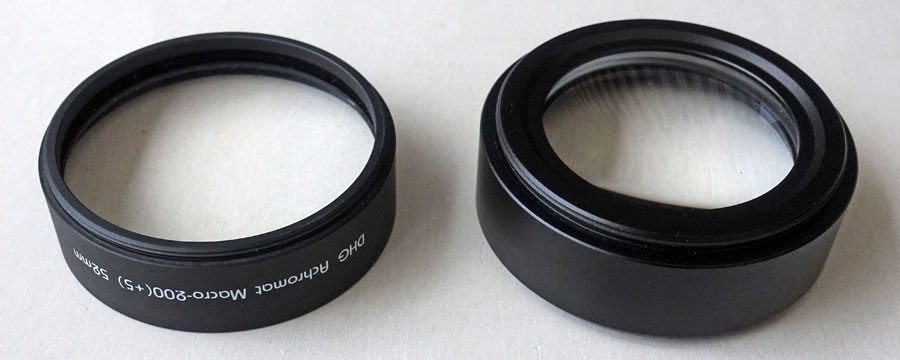 |
Photos: Marumi +5 achromat (left) and Dörr +10 achromat
Please note that the Dörr achromat is part of the Dörr slide copier and not available on its own.
 |
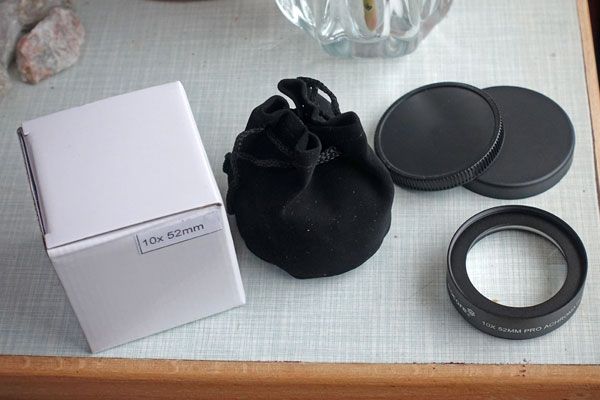 |
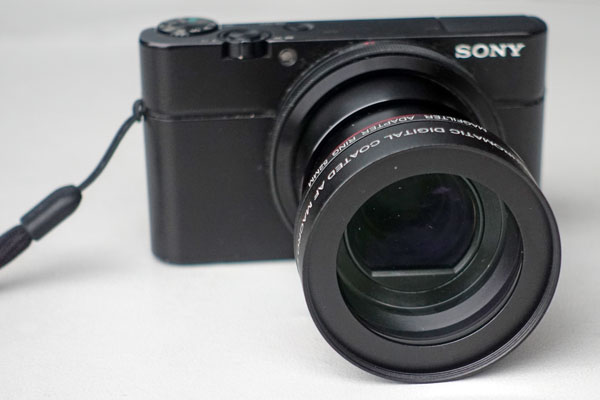 |
Photos: siocore +10 achromat with caps (left), caps off (center), and at the camera (right)
Weights: Dörr +10 = 85 g, Siocore +10 = 74 g , Marumi +5 = 58/59 g (all for a filter thread of 52 mm)
What Was Already Known...
When I measured the minimum object width for different zoom lengths (see here), I found out that only two zoom lengths are interesting for close-up shots, namely 28 mm and 100 mm (both equiv.). The latter provides a larger minimum object width (about 20 cm), but also a large object distance of 55 cm. Adding hand-held close-up lenses to these tests (see here), I got the following results for the minimum object width for the Sony RX100 M1 and M4 (see here and here):
Sony RX100 M1 |
Sony RX100 M4 |
||||||||
Focal
Length |
Close-up Lenses Setup |
Focal
Length |
|||||||
| None | M +5 | 2 x M +5 | D +10 | None | M +5 | 2 x M +5 | D +10 | ||
| 28 | 80 mm | 67 mm | 53 mm | 55 mm | 100 mm | n.a. | n.a. | n.a. | 24 |
| 100 | 200-205 mm | 62 mm | 36 mm | 37 mm | 161-162 mm | 68 mm | 46? mm | 46 mm | 70 |
All this can be found here. For the newer siocore +10 achromat, see below.
That is, at the telephoto end you get a minimum objects width of about 20 cm without a close-up lens, with a Marumi +5 achromat it is a little more than 6 cm, and with a Dörr +10 achromat (or two Marumi achromats) it is less than 4 cm. That means that with any of these achromats you get a smaller minimum object width than with a focal length of 28 mm (equiv.) without a close-up lens. (A close-up lens would lead to very short distances at 28 mm (equiv.), which makes this set-up unusable.)
New Test Shots Using a Ruler
Here are a few test shots at 100 mm equiv. using a ruler:
 |
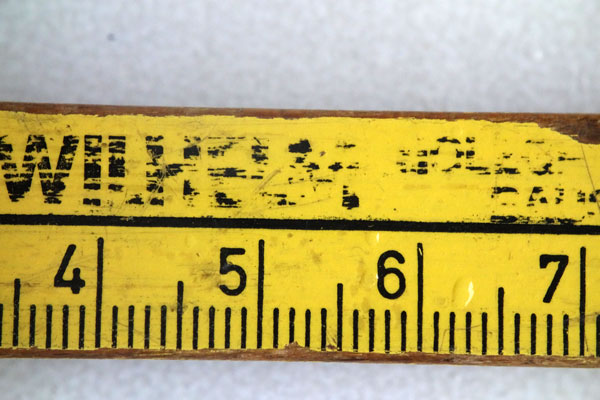 |
 |
||
One Marumi +5 achromat (6.0 cm) |
siocore +10 achromat (3.7 cm) |
Dörr +10 achromat (3.6 cm) |
||
 |
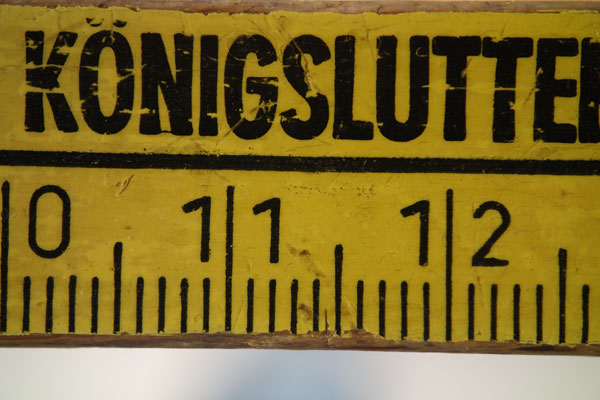 |
|
||
Dörr +10 achromat (3.7 cm) |
Marumi +5 and siocore +10 = +15 achromat (2.65 cm) |
|||
The +10 close-up lenses lead to about the same magnification, whereas for the Marumi +5 achromat alone, the minimum object width is a little bit less than in the previous test. For the Dörr +10 achromat, I got results between 3.6 and 3.7 cm, whereas the siocore +10 achromat achieved 3.7 cm. All in all, the results are comparable to my "hand-held" tests. Finally, I tested die Sony RX100 M1 with a Marumi +5 plus a siocore +10 achromat, that is, with a +15 achromat.
So this is my updated minimum object width table for the Sony RX100 M1 and M4:
Sony
RX100 M1 |
Sony RX100 M4 |
||||||||
Focal Length |
Close-up Lenses Setup |
Focal Length | |||||||
| None | +5 | +10 | +15 | None | +5 | +10 | +15 | ||
| 28 | 80 mm | 67 mm | 55 mm | n.a. | 100 mm | n.a. | n.a. | n.a. | 24 |
| 100 | 200-205 mm | 60-62 mm | 36-37 mm | 26-27 mm | 161-162 mm | 68-71 mm | 45-47 mm | 35 mm | 70 |
Measuring the distance to the object is somewhat difficult for me. Sony states a minimum distance of 55 cm for a focal length of 100 mm equiv., but this seems to mean that the distance is measured from the lens's control ring (which is difficult to observe in practice). I did not measure the minimum distance in this test, but in a later one, but then I measured the minimum object distance from the front lens or front of close-up-lens.
And this is my minimum object distance table for the Sony RX100 M1 and M4, measured from the front lens or front of close-up-lens:
Sony
RX100 M1 |
Sony RX100 M4 |
||||||||
Focal Length |
Close-up Lenses Setup |
Focal Length | |||||||
| None | +5 | +10 | +15 | None | +5 | +10 | +15 | ||
| 28 | 5 cm | 6.7 cm | 5.5 cm | n.a | 100 mm | n.a. | n.a. | n.a. | 24 |
| 100 | 55 cm | 13.5 cm | 8.5 cm** | 5.6 cm** | 27.5/30* cm | 11 cm | 7.5 cm | 5.2 cm | 70 |
*) Given by Sony; **) crude estimates, all other values estimates
Summary Table RX100 M1
|
Focal Length |
Minimum Object... |
Close-up Lenses
Setup |
|||
| None | +5 | +10 | +15 | ||
| 28 | Size > | 80 mm | 67 mm | 55 mm | n.a. |
| 100 | 200-205 mm | 60-62 mm | 36-37 mm | 26-27 mm | |
| 28 | Distance > | 5 cm | 2.5 cm** | 1.7 cm** | n.a. |
| 100 | 45/55* cm | 13.5 cm | 8.5 cm** | 5.6 cm** | |
*) Given by Sony; **) crude estimates, all other values estimates
Sample Photos
In the following, I simply show "real-world" test shots using different close-up lenses or combinations.
Real World Tests
Here, I set the minimum distance manually and tried to focus on the center of the flower.
Real World Photos
The following photos (April 2, 2018) were taken with a Marumi +5 achromat at 100 mm equiv., without much caring for maximum magnification.
 |
 |
|
References
- XP PhotoGear 52mm MagFilter Threaded Adapter Ring (B&H): www.bhphotovideo.com/c/product/1001725-REG/xp_photogear_xpmfa52_52mm_magfilter_adapter.html
- Carry Speed MagFilter Filteradapter auf 49, 52, 55 und 58mm (Carry Speed, Germany; in German): www.carryspeed.de/produkte/magadapter.html
| 20.04.2018 |








